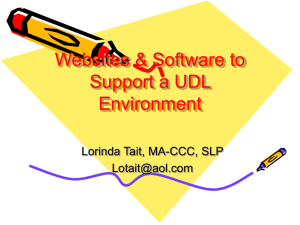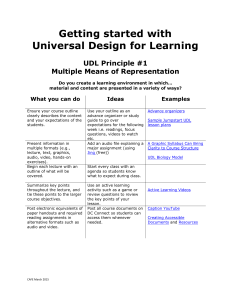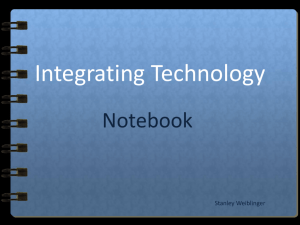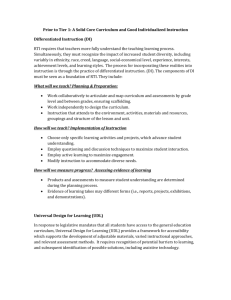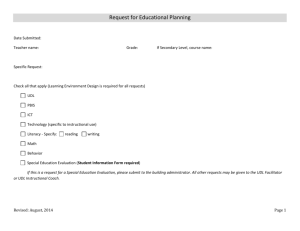Differentiated Instruction/Universal Design for Learning
advertisement
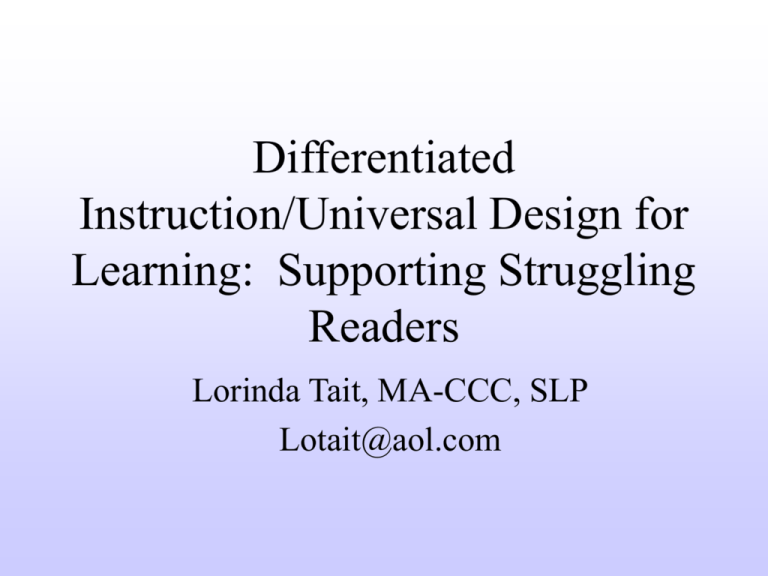
Differentiated Instruction/Universal Design for Learning: Supporting Struggling Readers Lorinda Tait, MA-CCC, SLP Lotait@aol.com Life is Simple! • What do you already know? • What is the focus of Universal Design for Learning? • What resources are there to supplement your teaching? • What websites are available? • What is differentiated instruction? Curriculum Barriers What is the focus of Universal Design for Learning? • To remove barriers to learning • To provide supports where they are needed • To engage every student in a successful learning experience Universal Design • The careful construction of curriculum and curriculum materials to encourage access for all students. • It refers to the features of a curriculum that make it compatible for a large (universal) audience. How does the UDL framework help us to do these things? • providing tools for building flexibility into the curriculum • supporting improved access to information and--to learning itself • providing multiple approaches to learning that will result in success for diverse learners. What tools and strategies does the UDL framework provide to help us accomplish these goals? • Multiple means of representation to give learners various ways of acquiring information and knowledge • Multiple means of expression to provide learners alternatives for demonstrating what they know • Multiple means of engagement to tap into learners' interests, offer appropriate challenges, and increase motivation Multiple means of representation: Use multiple formats and media • Highlight critical features (e.g., Use different colors of highlighters to identify the title, headings, main ideas and supporting details in an expository text) • Present multiple examples and nonexamples of a concept (e.g., Some examples of conflict are arguments and war. Non-examples include cooperating to solve a problem and working together to help someone.) • Support Background Knowledge Differentiated Instruction • Recognizes students have varying background knowledge, readiness, language, preferences in learning, interests. • A process to approach teaching and learning for students of differing abilities in the same class. • The intent is to maximize each student’s growth and individual success by meeting each student where he or she is, and assisting in the learning process. Differentiated Instruction • When you offer learners a choice of materials from a combination of traditional text, presentation and digital media, you can realistically provide differentiated instruction within the context of your busy, diverse classrooms. Use multiple formats and media to support learner differences: • Print – Textbooks and Trade Books – Newspapers and Magazines – Considerate, age-appropriate texts (like Startto-Finish® books) – Web content on any subject at a variety of difficulty levels Websites • NASA explores site http://www.nasaexplores.com/ • Windows to the Universe http://www.windows.ucar.edu/ • Ben’s Guide to U.S. Government for Kids http://bensguide.gpo.gov/ Literature/Language Arts • The Children’s Literature Web Guide www.ucalgary.ca/~dkbrown • Online Classic Literature Library http://www.literature.org/authors/ • SparkNotes-Classic Books Online http://www.sparknotes.com/texts • Project Gutenburg http://promo.net/pg/ • American Library Association • http://www.ala.org/parentspage/greatsites/ Videos for Download • • The Prelinger Archives offer over 45,000 advertising, educational, industrial, and amateur films. Since its beginning in 1983, its goal has been to collect, preserve, and facilitate access to films of historic significance that haven't been collected elsewhere. The collection is open to all for free downloading and reuse but not sold. Media Channel: Scroll down to the middle of this page to find and extensive list of links. Many, but not all, link to video clips. Some cannot be downloaded, but the items that are available cover a range of interesting current topics. • • • • • Exploration in Education offers Electronic Tutorials form a NASA supported program. Apple Learning Interchange: Videos as well as the ways teachers have incorporated them into the classroom are scattered throughout this site. Lesson plans and study guides can be downloaded as well. Perseus Project contains a video about the ancient Olympic games; also take a look at the other collections offered on this site. Career Videos offers 360 captioned videos each about a different career. edutopia online, the George Lucas Foundation site - discuss topics relevant to today?s classrooms. Audio Books – (free, via subscription or CD-based such as Start-to-Finish books) – Software programs that translate printed text into speech (like SOLO®, Read:OutLoud, Aspire Reader, WYNN, TestTalker) used with text files available through the Internet and/or directly through publishers (NIMAS) Visual – Graphic organizers—both print-based and electronic programs (like SOLO, Read:OutLoud, Draft:Builder®, Inspiration, Kidspiration, Visual Thesaurus).http://www.ncrel.org/sdrs/areas/issues/st udents/learning/lr1kwlh.htm http://school.discovery.com/schrockguide/newtheme02 06.html – Considerate, age-appropriate educational videos intended for use as learning "anchors" (like Incite!) and/or full-length videos or video clips (available free or by subscription) More Visual – Graphics libraries that include photographs, illustrations and animations (available free or by subscription via the Internet, on CD) – Multimedia—Text, sound, graphics, animation and video software (like PowerPoint, HyperStudio, Kid Pix) Digital Media • Present information in multiple modes and with multiple levels of support to challenge as well as scaffold learners across a wide range of needs and abilities. • Save, share and use from class-to-class, teacherto-teacher and year-to-year, expanding the options you have available to individualize learning in your classroom. • Saves time while assuring that more learners are successfully included in meaningful learning. General Sources • KidsClick was created by a group of librarians at the Ramapo Catskill Library System, articles listed with illustration information and readability level. http://www.kidsclick.org • Pink Monkey http://www.pinkmonkey.com • California State University, Northridge: Current events and electronic resources for kids. http://www.csun.edu/~hcedu013/cevents.html More Sources • Internet Public Library, Youth Division http://www.ipl.org/div/kidspace • Internet Public Library, Teen Division http://www.ipl.org/div/teen/ • Awesome Library http://www.awesomelibrary.org/Classroom/ Technology/Technology.html • Discovery School http://school.discovery.com/students/ • Class Homework http://www.classhomework.com/ Social Studies • Library of Congress http://lcweb2.loc.gov/amhome.html • National Geographic for Kids http://www.nationalgeographic.com/kids/ • National Park Service/Historic Places http://www.cr.nps.gov/nr/twhp/ UDL Solutions • • • • Look at 3 brain networks: Recognition Strategic Affective Vocabulary Instruction • Traditionally, students define vocabulary words prior to reading a passage or chapter. • Students create sentences using vocabulary from a reading passage. Vocabulary UDL • Read and pick out the high frequency words that students do not know but need to acquire in order to have a rich vocabulary. • Write student-friendly explanations, the dictionary definition for a word like occurrence might be overly complicated, but a simple definition like something that happens will have more meaning for students. • Create student-friendly definitions by using everyday language to explain meaning. UDL Way • Introduce words before reading • Record words in a journal • Explore word meanings -The goal of this activity is to encourage students to think about how words are used and how they fit together. Use words • Have students create examples of word meanings, such as the following: – Describe a time when you were incredulous. – Describe how a humane person acts. • Have students respond to questions about sentences containing vocabulary words: – When I told my teacher that my dog ate my homework, she was incredulous. What do you think the teacher thought? – A large group of people gathered outside the UN to demand that the Chinese government treat political prisoners more humanely. What kind of treatment do you think people are demanding for the prisoners? Why would they demand it? • Give students quizzes and tests on vocabulary definitions. Center for Applied Special Technology www.cast.org • Founded in 1984 CAST has earned international recognition for its development of innovative, technologybased educational resources and strategies based on the principles of Universal Design for Learning (UDL). • CAST staff includes specialists in education research and policy, neuropsychology, clinical/school psychology, technology, engineering, curriculum development, K-12 professional development, and more. • By defining UDL and exploring its practical applications, CAST is pushing the boundaries of education research, practice, and policymaking. Achievements include: • Creation or codevelopment of innovative software such as Thinking Reader, WiggleWorks, and Bobby What do you know now? • What is the focus of Universal Design for Learning? • What resources are there to supplement your teaching? • What websites are available? • What is differentiated instruction? • Lorinda Tait • Lotait@aol.com Subject: MACUL • Thanks for coming!!!
